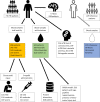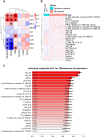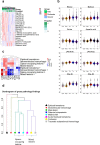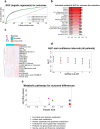Serum metabolome associated with severity of acute traumatic brain injury
- PMID: 35538079
- PMCID: PMC9090763
- DOI: 10.1038/s41467-022-30227-5
Serum metabolome associated with severity of acute traumatic brain injury
Abstract
Complex metabolic disruption is a crucial aspect of the pathophysiology of traumatic brain injury (TBI). Associations between this and systemic metabolism and their potential prognostic value are poorly understood. Here, we aimed to describe the serum metabolome (including lipidome) associated with acute TBI within 24 h post-injury, and its relationship to severity of injury and patient outcome. We performed a comprehensive metabolomics study in a cohort of 716 patients with TBI and non-TBI reference patients (orthopedic, internal medicine, and other neurological patients) from the Collaborative European NeuroTrauma Effectiveness Research in Traumatic Brain Injury (CENTER-TBI) cohort. We identified panels of metabolites specifically associated with TBI severity and patient outcomes. Choline phospholipids (lysophosphatidylcholines, ether phosphatidylcholines and sphingomyelins) were inversely associated with TBI severity and were among the strongest predictors of TBI patient outcomes, which was further confirmed in a separate validation dataset of 558 patients. The observed metabolic patterns may reflect different pathophysiological mechanisms, including protective changes of systemic lipid metabolism aiming to maintain lipid homeostasis in the brain.
© 2022. The Author(s).
Conflict of interest statement
The authors declare no competing interests.
Figures




Similar articles
-
Human Serum Metabolites Associate With Severity and Patient Outcomes in Traumatic Brain Injury.EBioMedicine. 2016 Oct;12:118-126. doi: 10.1016/j.ebiom.2016.07.015. Epub 2016 Jul 15. EBioMedicine. 2016. PMID: 27665050 Free PMC article.
-
Plasma metabolomics profiles in rats with acute traumatic brain injury.PLoS One. 2017 Aug 3;12(8):e0182025. doi: 10.1371/journal.pone.0182025. eCollection 2017. PLoS One. 2017. PMID: 28771528 Free PMC article.
-
Metabolomic in severe traumatic brain injury: exploring primary, secondary injuries, diagnosis, and severity.Crit Care. 2025 Jan 15;29(1):26. doi: 10.1186/s13054-025-05258-1. Crit Care. 2025. PMID: 39815318 Free PMC article.
-
Metabolomics and Biomarker Discovery in Traumatic Brain Injury.J Neurotrauma. 2018 Aug 15;35(16):1831-1848. doi: 10.1089/neu.2017.5326. J Neurotrauma. 2018. PMID: 29587568 Review.
-
Metabolomics in severe traumatic brain injury: a scoping review.BMC Neurosci. 2023 Oct 16;24(1):54. doi: 10.1186/s12868-023-00824-1. BMC Neurosci. 2023. PMID: 37845610 Free PMC article.
Cited by
-
Metabolome-Wide Mendelian Randomization Assessing the Causal Role of Serum and Cerebrospinal Metabolites in Traumatic Brain Injury.Biomedicines. 2024 May 25;12(6):1178. doi: 10.3390/biomedicines12061178. Biomedicines. 2024. PMID: 38927385 Free PMC article.
-
Probiotic therapy modulates the brain-gut-liver microbiota axis in a mouse model of traumatic brain injury.Biochim Biophys Acta Mol Basis Dis. 2024 Dec;1870(8):167483. doi: 10.1016/j.bbadis.2024.167483. Epub 2024 Aug 28. Biochim Biophys Acta Mol Basis Dis. 2024. PMID: 39209236 Free PMC article.
-
Candidate Molecular Biomarkers of Traumatic Brain Injury: A Systematic Review.Biomolecules. 2024 Oct 11;14(10):1283. doi: 10.3390/biom14101283. Biomolecules. 2024. PMID: 39456216 Free PMC article.
-
Acute effects of single and repeated mild traumatic brain injury on levels of neurometabolites, lipids, and mitochondrial function in male rats.Front Mol Neurosci. 2023 Jun 29;16:1208697. doi: 10.3389/fnmol.2023.1208697. eCollection 2023. Front Mol Neurosci. 2023. PMID: 37456524 Free PMC article.
-
Proteomic analysis discovers potential biomarkers of early traumatic axonal injury in the brainstem.Int J Legal Med. 2024 Jan;138(1):207-227. doi: 10.1007/s00414-023-03039-5. Epub 2023 Jun 20. Int J Legal Med. 2024. PMID: 37338605

